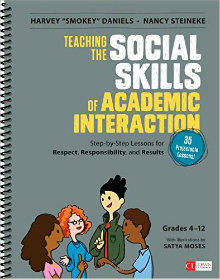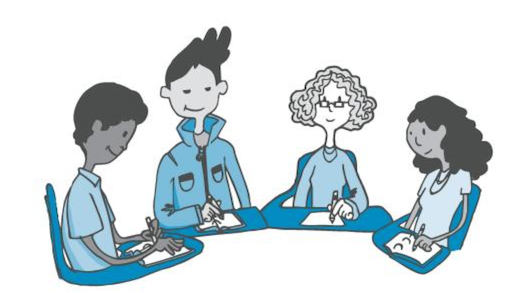Teaching Our Students Academic Social Skills
Teaching the Social Skills of Academic Interaction, Grades 4-12: Step-by-Step Lessons for Respect, Responsibility, and Results
By Harvey “Smokey” Daniels and Nancy Steineke
(Corwin Literacy, 2014 – Learn more)

Let me get this out of the way first. I find it so inspiring that when Smokey Daniels and Nancy Steineke were looking for an illustrator for their new book about social skills and academic interactions in the classroom, they turned to a young New Hampshire artist, Satya Moses, who then proceeds to infuse this book and its accompanying presentation slides with a burst of youthful energy.
In choosing an artist like Moses, Daniels and Steineke hit just the right tone for presenting lessons around interactions in the classroom to be used with students. Brilliant move!

I have worn-out copies of many of their books, with many thumbed pages and sticky notes, in my classroom, and I tap into their ideas regularly. In the Western Massachusetts Writing Project, we are even using their Content-Area Writing book (with co-author Steve Zemelman) in a year-long professional development project with teachers at an inner city STEM-themed middle school.
A realistic invitation to engaged learning
This book, Teaching the Social Skills of Academic Interaction, is different in many ways from some of their previous collections, yet it shares a similar tone and ethos. As always, their writing style invites you into the learning in a very engaging way, complete with realistic expectations of where things may go right and where things may go wrong – and how to get the lesson back on the right track if that happens.
The book is as much a sharing of ideas as it is a collection of “projectable lessons” (powerpoints you can download from the publisher’s site) for students in grades four through twelve. These ideas and lessons connect deeply with the Common Core push to elevate the role of speaking and listening, and interaction, in the classroom.
The impetus for the book is based on the sobering reality of most classrooms where teachers want to see more group discussions and group projects: it doesn’t always go the way it should because young people bring their own social skills to the table, and not always in a positive way.
No matter how we politely phrase it, a perennial problem is that our kids don’t all get along. They don’t work together easily. Too often, they hassle, disrespect, and put each other down. When we place them with partners, or in groups, they goof off, waste time, careen off task, or pick on each other. We watch this with rising levels of discomfort, trying to put a lid on the fractiousness, the negativity.” (Page 1)
Yep.
From basic to complex academic interactions
Starting from the very first lesson here, Daniels and Steineke walk both the teacher and their students through the motions of how to create a supportive community for academic discussions and learning, moving from the very basics of working in small groups or partners to the more complex tasks of group projects.
The downloadable presentations are peppered with art by Satya Moses, with recurring characters and themes. I think it might be a stretch to use some of these ideas with high school students, particularly juniors and seniors, but everything here is adaptable to circumstances.

I should note, though, that the authors strongly suggest that we don’t skimp on the initial community building aspects of our classroom, as work done early in the year on that topic will pay dividends later on.
My favorite part
I enjoyed this whole book, but what really drew me in is the later section around “Arguing Agreeably,” and here is where this book will come in handy for my own sixth grade classroom. With lessons entitled “Text Nuggets: Finding Evidence” and “Where Do You Stand?” and “Civilized Disagreement,” these lessons are exactly what I have been looking for in strengthening the teaching of argument in my classroom.
I love that the activities have students moving around the room, interacting in various ways before the writing and processing actually begin. I can already anticipate how these lesson ideas will fold in perfectly with the unit on argument that I already have in place, and how the social elements can enhance the writing element.
Kevin Hodgson is a sixth grade teacher in Southampton, Massachusetts, and is the technology liaison with the Western Massachusetts Writing Project. Kevin blogs regularly at Kevin’s Meandering Mind and tweets more often than is healthy under his @dogtrax handle.


































